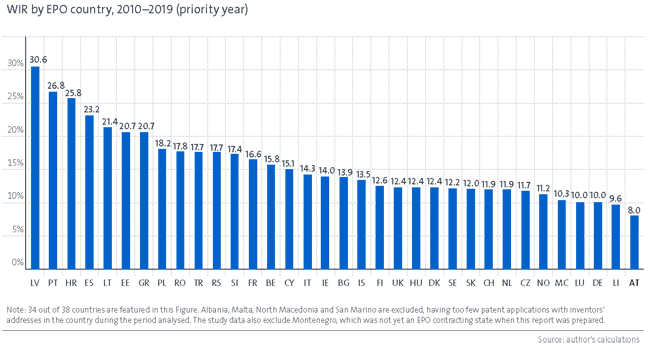Women and patents in Europe: new EPO study provides data, evidence and insights on gender gap
A new study published by the European Patent Office confirms that there is still a disproportionately low number of women from European patent member states applying for European patents; the gender gap is out of scale with the percentage of women who are active in business and science, and is wider in Europe than in other countries such as the United States, China and South Korea.
How inclusive is inventive activity in Europe? Are women scientists being denied equal opportunities?
A study published in November 2022 by the European Patent Office (EPO) provides current and accurate data, insights and evidence concerning gender and patents in member states of the European Patent Organisation and clearly aims to help policymakers, as well as the general public, to answer those questions and address the underlying issues.
Women’s participation in inventive activity – Evidence from EPO data, published in November 2022, is the first study carried out by the EPO to examine women’s presence among inventors in European patent applications in 38 member states; it focuses almost entirely on all European patent applications filed between 1978 and 2019, and attributes gender to inventors based on their names.
Progress in reducing gender gap
The study shows that while real progress has been made in recent decades, with the rate of women inventors in European Patent applications rising from 2% in the late 1970s to 13.2% in 2019, there is still clear evidence of a disproportionately low number of women applying for patents; moreover, the gender gap is wider in Europe than in other parts of the world such as the United States (15%), China (26.8%) and South Korea (28.3%).
Rates of women inventors in EPO member states
European Patent Organisation member states with the highest rate of women named as inventors in European patent applications in the years 2010 to 2019 (see figure) are Latvia, Portugal and Croatia while Germany, Liechtenstein and Austria have the lowest. Italy ranks among the top half, 16th out of the 34 states for which the data are available.

Graphic representation of the Women Invention Rate (WIR), meaning the percentage of women named as inventors in patents, for 34 EPO member states in the years 2010 to 2019. Source: Women’s participation in inventive activity – Evidence from EPO data.
The differences between states are largely due to technology specialisations and to the contribution of universities and public research organisations to patenting activity.
For instance chemistry, and especially biotechnology and pharmaceuticals, are by far the technology sectors with the highest rates of women inventors, and the same goes for patent applications originated by universities and public research entities as opposed to those coming from businesses or individual inventors.
Women in business, science and patents
The study compares the rate of women’s participation in patenting activity with indicators of their presence in other economic and scientific activities in the top nine EPO countries in terms of patenting at the EPO: Belgium, Denmark, France, Germany, Italy, the Netherlands, Spain, Sweden and the United Kingdom.
The evidence is that for all nine states the share of women in total employment is generally between 40% and 50%, but their share among inventors in European Patents is on average only between 10% and 20%, in spite of all countries but one having a rate of 30% or more women among STEM PhD graduates as well as among R&D and research staff.
The study concludes that although the contribution of women to patenting has grown over time, it is far not only from being gender-balanced, but also from catching up with the numbers of women active in economic and scientific activities in general, and in particular with the share of women among PhD graduates and researchers.
